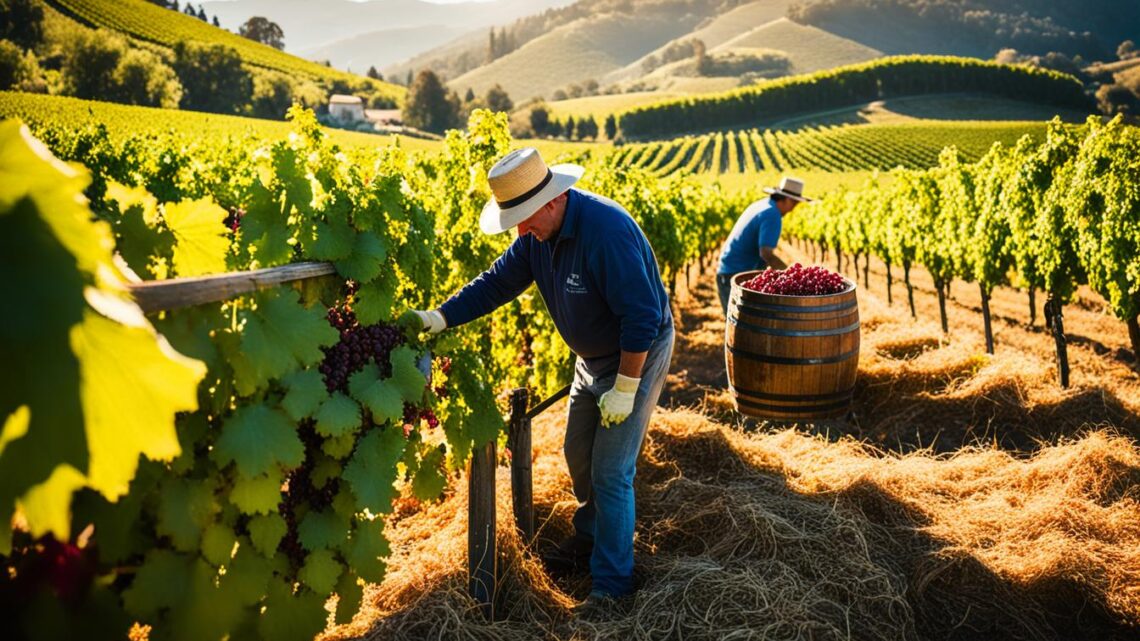
Ever wondered how the wines we love come to be? The journey from grape to glass is fascinating, filled with history and the art of winemaking. Let’s explore the secrets behind turning simple grapes into the divine drink we cherish.
The art of making wine is a blend of tradition, innovation, and a love for the earth. Every step, from growing the grapes to fermenting them, is crucial. What makes some wines stand out? Let’s dive into the world of winemaking and find out what makes a grape a masterpiece.
Unveiling the Stages of Wine Production
From Vine to Bottle: A Comprehensive Overview
The journey of making wine starts with picking the best grape varieties for the job. These grapes grow in the ideal terroir. Weather, soil, and when to harvest them all play a big part in the wine’s taste. Growers watch over the viticulture closely, knowing just when to pick the grapes by hand or with machines.
After picking, the grapes go through crushing and pressing. This gets the juice out, which is key for the wine. For red wines, the grape skins stay in to give the wine its color and tannins. This process, called fermentation, can take from 10 days to a month. It turns grape sugars into alcohol, creating different ABV levels.
Next, the wine is cleaned up through clarification. This removes any unwanted bits or sediment. Sometimes, winemakers add things like egg whites to help settle the solids. Then, the wine goes into oak barrels, stainless steel tanks, or other containers for aging. This is where the wine gets its special smell and taste.
At the end, the wine is bottled and ready for people to enjoy. How long it ages can vary, from a few months to years, based on the wine type and the winemaker’s goals.

- Grape variety selection
- Terroir considerations
- Optimal harvesting time
- Mechanical or hand harvesting
- Crushing and pressing
- Fermentation process
- Clarification and fining
- Aging in barrels, tanks, or bottles
- Bottling and packaging
| Process | Key Factors | Typical Duration |
|---|---|---|
| Harvesting | Sugar content, acidity, pH | 1-2 weeks |
| Fermentation | Yeast addition, temperature control | 10 days to 1 month |
| Clarification | Fining agents, filtration | 2-4 weeks |
| Aging | Oak barrel, stainless steel, bottle | 3 months to several years |
Wine Production: A Dance of Art and Science
Winemaking is a mix of art and science. It requires the winemaker’s expertise and focus. From the start, with fermentation, yeast turns grape juice sugars into alcohol. Then, malolactic conversion softens the wine’s acidity.
For red wines, the juice stays with the grape skins. This process gives the wine its color and tannins. White wines, on the other hand, are made without the skins. The oak aging process adds complexity and nuance, with winemakers choosing the right oak barrels.
The last step, clarification, removes impurities and sediments. Winemakers use fining and filtration for this. This careful attention makes the world’s best wines stand out, blending art and science in winemaking.
| Winemaking Stages | Description |
|---|---|
| Fermentation | The process where yeast converts the sugars in grape juice into alcohol, determining the final alcohol content and flavor profile of the wine. |
| Malolactic Conversion | A bacterial process that softens the wine’s acidity, an important step in the winemaking process. |
| Oak Aging | Imparts additional complexity and nuance to the wine, with winemakers carefully selecting the type and age of oak barrels. |
| Clarification | The final stage that ensures the wine is free of impurities and sediments, using techniques like fining and filtration. |
Winemaking is a delicate dance. It combines the winemaker’s skills, attention to detail, and artistic touch. From the start to the end, each step shows the winemaker’s talent and hard work.
Exploring the Nuances of Terroir and Grape Varieties
The quality of grapes is key to making great wine. Terroir, which includes grape variety, climate, soil, and more, shapes a wine’s unique taste. Different grapes like Cabernet Sauvignon, Chardonnay, and Pinot Noir have their own tastes and grow best in certain places.
Winemakers pick the right grapes for their area and use techniques like pruning to get the best grapes. These choices affect the wine’s style and quality. Places like Burgundy and Piedmont in Europe and new areas like Oregon and South Africa focus on terroir and grape variety.
Wines from California’s Pinot Noir to Burgundy’s earthy taste show terroir’s impact. Laws protect these wines and keep their unique traditions alive. This makes the wine world exciting and diverse.



